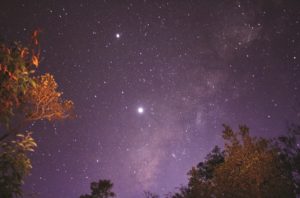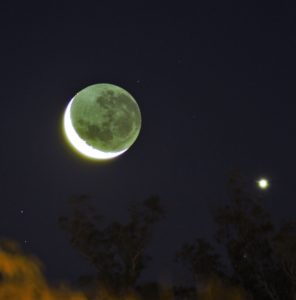The Moon and four bright planets put on a playful show this month. No telescope or binoculars are needed, and, fortunately for us during this cold winter stretch, the action is at dusk, not dawn.
Your best skywatching this month can begin about 30 minutes after sunset. Venus has returned as the evening star after a couple of months hiding in the Sun’s glare. You’ll see it low in the west — look for a brilliant blue-white star close to the horizon. Look just above Venus and you’ll see a fainter, reddish-yellow star. That’s Saturn. Saturn and Venus will draw closer together each night until the 22nd, when they’ll be about one full Moon’s width away from each other.

When two objects appear very close together like this, astronomers call it a conjunction. Saturn and Venus aren’t actually close — they’re over a billion miles from each other. But from our point of view they (and occasionally other objects in the night sky) sometimes appear to come very close to each other.
After January 22, Venus will climb higher each night while Saturn sinks lower. Eventually Saturn will leave our night sky for a while. But Venus’s setting time will shift a little later each night for the next several months, becoming more and more prominent in the early evening. In May its motion will reverse, and it will begin setting earlier each night, until it vanishes for a time.
This varying motion of Venus is due our differing orbits. Venus is the next planet in towards the Sun from Earth. This means that it completes an orbit around the Sun in less time than we do. Right now Venus is closing the distance with us, drawing a little closer to Earth every day. In May it will catch up and then pass us. When it does, its apparent motion in our sky reverses.

Something similar happens with the planets further from the Sun than Earth: Mars, Jupiter, and Saturn (I’m only including the planets visible to the unaided eye). Earth orbits the Sun in less time than these outer planets do, so their respective motion changes throughout the year as Earth approaches, catches up, and then passes them.
Returning to the January night sky, once you’ve found Venus and Saturn, look high overhead, where you’ll see a bright red star. That’s Mars. You may notice a dimmer star nearby, also with a similar reddish hue. That’s Aldebaran, the eye of the bull in the constellation Taurus.
Next look to your right, towards the west, and a little lower in the sky for a bright golden-white star. That’s Jupiter. It’s not often that four planets are easily visible like this at such a convenient hour, soon after sunset. And it gets better.
On January 25, the crescent Moon appears in the southwest at dusk. Look for Jupiter very close by — it’s a Moon-Jupiter conjunction. The Moon will creep higher each night as it waxes, showing more and more of its face to us. On January 28, the Moon will be between Mars and Jupiter. If you’re outside right at dusk, you’ll be able to see the four planets and the Moon together for a short time before Saturn, and then Venus, set. Finally on January 30 we’ll have a Moon-Mars conjunction, with a gibbous (past half) Moon close to Mars.
A celestial dance like this is a fun way to start the new year. Bundle up, find yourself a spot with an open view of the sky, and take it all in. Clear skies!



